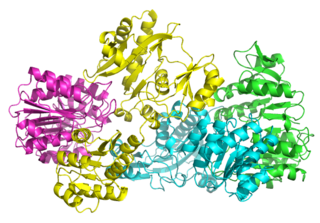Succinyl-coenzyme A, abbreviated as succinyl-CoA or SucCoA, is a thioester of succinic acid and coenzyme A.

Succinyl coenzyme A synthetase is an enzyme that catalyzes the reversible reaction of succinyl-CoA to succinate. The enzyme facilitates the coupling of this reaction to the formation of a nucleoside triphosphate molecule from an inorganic phosphate molecule and a nucleoside diphosphate molecule. It plays a key role as one of the catalysts involved in the citric acid cycle, a central pathway in cellular metabolism, and it is located within the mitochondrial matrix of a cell.

In enzymology, a 3-oxoacid CoA-transferase is an enzyme that catalyzes the chemical reaction
In enzymology, a 3-oxoadipate CoA-transferase is an enzyme that catalyzes the chemical reaction
In enzymology, an acetate CoA-transferase is an enzyme that catalyzes the chemical reaction
In enzymology, a succinate-citramalate CoA-transferase is an enzyme that catalyzes the chemical reaction
In enzymology, a succinate-hydroxymethylglutarate CoA-transferase is an enzyme that catalyzes the chemical reaction

In enzymology, a succinate-CoA ligase (ADP-forming) is an enzyme that catalyzes the chemical reaction

In enzymology, a succinate—CoA ligase (GDP-forming) is an enzyme that catalyzes the chemical reaction

The enzyme 3-hydroxyisobutyryl-CoA hydrolase (EC 3.1.2.4) catalyzes the reaction
The enzyme acetoacetyl-CoA hydrolase (EC 3.1.2.11) catalyzes the reaction
The enzyme acetyl-CoA hydrolase catalyzes the reaction
The enzyme acyl-CoA hydrolase (EC 3.1.2.20) catalyzes the reaction
The enzyme hydroxymethylglutaryl-CoA hydrolase (EC 3.1.2.5) catalyzes the reaction
Palmitoyl-CoA hydrolase (EC 3.1.2.2) is an enzyme in the family of hydrolases that specifically acts on thioester bonds. It catalyzes the hydrolysis of long chain fatty acyl thioesters of acyl carrier protein or coenzyme A to form free fatty acid and the corresponding thiol:
In enzymology, a succinyl-diaminopimelate desuccinylase (EC 3.5.1.18) is an enzyme that catalyzes the chemical reaction
In enzymology, a 3-oxoadipyl-CoA thiolase is an enzyme that catalyzes the chemical reaction

Acyl-coenzyme A thioesterase 4 is an enzyme that in humans is encoded by the ACOT4 gene.
Succinate-semialdehyde dehydrogenase (acylating) (EC 1.2.1.76, succinyl-coA reductase, coenzyme-A-dependent succinate-semialdehyde dehydrogenase) is an enzyme with systematic name succinate semialdehyde:NADP+ oxidoreductase (CoA-acylating). This enzyme catalyses the following chemical reaction

3-Hydroxyisobutyryl-CoA deacylase deficiency is a rare autosomal recessive condition that is associated with severely delayed psychomotor development, neurodegeneration, increased lactic acid and brain lesions in the basal ganglia. Fewer than 10 patients have been described with this condition.






